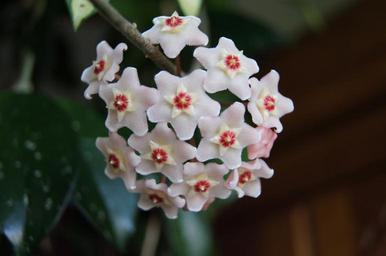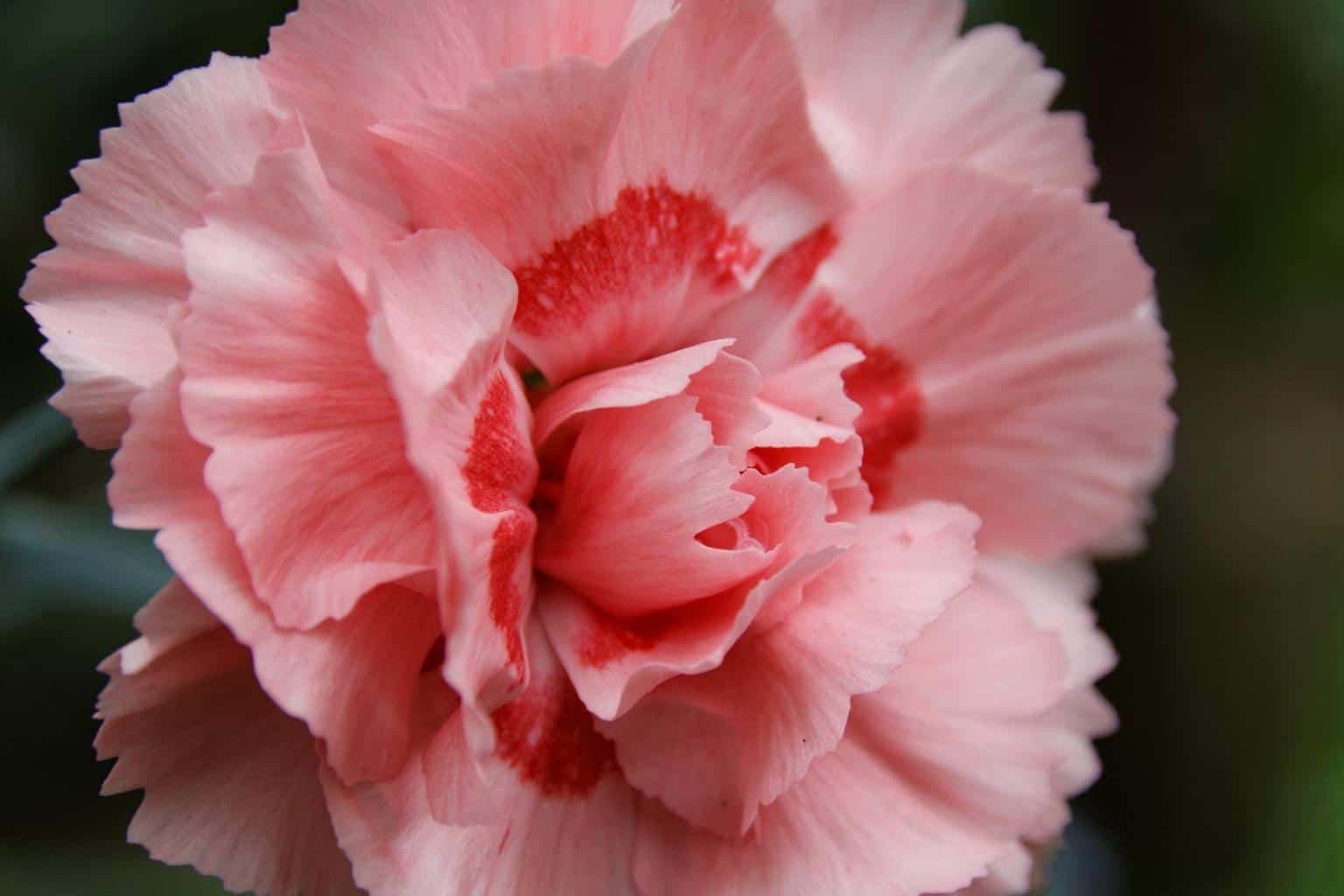The Wax Plant, or Hoya Carnosa, is a species of flowering perennial that belongs to the Apocynaceae family. It has been popular among gardeners and houseplant enthusiasts for centuries due to its dazzling star-shaped blooms.
This plant is generally categorized as a perennial and is fairly hardy. It reaches an average maximum height of about four feet, but its sprawling branches can extend up to six feet. Yellowish-green leaves appear along the length of the vine-like stems, complemented by the star-shaped white, to light pink flowers that emerge during the bloom season. Wax Plants are known to produce excess nectar which attracts pollinators from afar and gives off a sweet scent.
How to Plant and Grow Wax Plant
The Wax Plant grows best in bright, indirect sunlight and in a location where the temperature won’t drop below 10⁰C or rise above 20⁰C. Although the Wax Plants can survive in a variety of soil conditions, they do best in well-draining, slightly acidic soils with a pH between 5.5 and 6.5. It is important to keep the soil consistently moist but never soggy. Wax Plants should be fertilized with a balanced, slow-release fertilizer during the growing season and require regular pruning to keep the plant neat and compact.
Meaning and Symbolism
The Hoya Carnosa is native to tropical regions of India, and thus, it has a few traditional meanings associated with it. The flowers of the Wax Plant were considered a symbol of beauty and also used to symbolize a family’s wealth and success.
In addition, this flower was highly appreciated in ancient India for its connection to the Hindu gods like Ganesh and Krishna.
Nowadays, the Wax Plant is seen as a representation of patience, perseverance, and hard work, due to its resilience and elegant, star-shaped flowers.
History, Mythology and Religious Significance
The Hoya Carnosa, or Wax Plant, dates back to the Victorian era.
It is believed to have been primarily cultivated in India, in the tropical and sub-tropical regions. During this period, it was primarily grown as a houseplant and its beautiful blooms were used to create garlands and decorations within the house.
In ancient India, the Hoya Carnosa was symbolically associated with the Hindu gods and goddesses. It was believed that flowers of this species were favored by the god Ganesh, who is known to bring prosperity and good luck. In Hindu mythology, the divine being Krishna was also said to be fond of these flowers and garlands were often made as offerings to a temple of Krishna.
In religion, the Wax Plant is viewed as a symbol of faith and commitment. In some areas of India, this flower was used as an offering to the gods in temples. It was also used for celebrating special occasions and rituals.
Flower Varieties and Their Defining Characteristics
The Wax Plant, or Hoya Carnosa, is an evergreen, perennial species of the Apocynaceae family. It grows in vine-like structures and produces star-shaped white to light pink blooms. Its yellowish-green leaves appear along the length of the stems.
Wax Plant Varieties
There are several varieties of the Wax Plant, with some of the common ones including:
- Polar Star: This variety is known for its white or pink-tinted flowers and has a sweet, mild scent. Its blooms have five petals that curve outward, making it look like an open star.
- Rubra: Its distinguishing characteristics are its red or pinkish flowers that have five rectangular petals and a sweet smell.
- Silver Teardrop: As its name suggests, it is known for its lush silver-green foliage and pink or white blooms. Its flowers are shaped like a tear drop, making it a noteworthy variety.
- Coronaria: This variety produces white to cream-colored flowers with yellowish centers, making them look like tiny crowns.
- Black-headed: This variety is characterized by its deep maroon, bell-shaped flowers with black petals.
How to Pot and Repot
The Wax Plant is relatively easy to maintain and can thrive in both outdoor and indoor environments. Before planting it outdoors, it is important to choose a spot that offers indirect sunlight and a well-draining soil. Cover the roots with potting soil and water mildly, making sure the soil is evenly moist but not soggy. For indoor cultivation, pot the Wax Plant in a container filled with moist soil and place it in a location with bright indirect sunlight.
When potting or repotting the Wax Plant, choose a container with drainage holes and fill it with a soil mixture of two parts potting mixture and one part coarse sand. Place the pot in a location with bright, indirect light and water the plant as needed. Make sure to not over-water the plant or it will be prone to root rot.
How to Prune
Pruning the Wax Plant helps to promote healthy growth and keep the plant neat and compact. Pruning the stems can be done all year round, however, the best time to do this is in the winter or early spring while the plant is dormant. This will help to promote new growth and prevent it from becoming too large. Use pruning shears and snip off any dead or overgrown stems. This will help increase air circulation to the plant and reduce the risk of disease.
How to Propagate
The best way to propagate the Wax Plant is through stem cuttings. While pruning the plant, collect several healthy and pest-free stems. Cut the stems in 4 inch segments, making sure that each segment has at least two leaves. Dip the cuttings in rooting powder and stick the cuttings into a pot filled with a soil and sand mixture. Water it regularly and make sure the soil stays moist.
Common Pests and Diseases
The Wax Plant is generally pretty resistant to any pests or diseases, however, it is prone to some. Some common problems include mealybugs, aphids, spider mites, and fungal diseases. These can affect the leaves of the plant, making them curl and yellow.
To prevent the spread of pests and diseases, it is important to inspect it regularly and to use an insecticide that is suitable for use on the Wax Plant. In addition, it is best to keep it away from other plants, as some diseases can spread easily.
Three Frequently Asked Questions About Hoya Carnosa
Q: Is Hoya Carnosa poisonous to animals?
A: Hoya Carnosa is generally not toxic to animals. However, it should not be consumed in large quantities as it can cause an upset stomach or allergies in pets.
Q: What color is the Wax Plant?
A: The Wax Plant has white to light pink star-shaped flowers with yellowish-green leaves.
Q: Does the Wax Plant flower all year round?
A: No, the Wax Plant typically blooms during the spring season.
Fact Sheet
| Wax Plant | Hoya Carnosa |
|---|---|
| Family | Apocynaceae |
| Plant Type | Perennial |
| Mature Size | 4-6 Feet |
| Sun Exposure | Bright, indirect sunlight |
| Soil Type | Well-draining, slightly acidic |
| Soil pH | 5.5 – 6.5 |
| Bloom Time | Spring season |
| Flower Color | White to light pink |
| Hardiness Zones | 9-11 |
| Native Area | India |
What we love from Amazon this week
Buy these wonderful flowers directly from Amazon:















